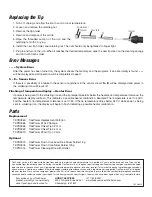
5.
To change temperature units:
Use the “
UP
” and “
DOWN
” buttons to change between 1C (for Celsius) or 1F (for
Fahrenheit).
6. When desired unit is displayed, press
the “
*
” button. The station is now in
heater error temperature tolerance
setting. The temperature will be
displayed with the 100’s digit fl ashing.
7. To change heater error temperature
tolerance, use the same steps in
“
Setting the Temperature”
section. The temperature setting for the heater error temperature tolerance must be within
the following range.
For °C:
30-150° C.
For °F:
60-300° F. If a temperature value outside of this range is selected, the
display will return to fl ashing the 100’s digit. If this happens, re-enter a temperature within the range.
8. After entering the heater error temperature tolerance, the station will display the room temperature compensation value.
To calibrate the tip use the following steps:
A. Allow the soldering station to cool to room temperature
for one hour.
B. Use a thermometer to measure the room temperature.
C. Use a small regular or a cross point screw driver to adjust
the screw marked “CAL” on the soldering station until
the display indicates the room temperature measured
by the thermometer.
9. Press the “
*
” button to exit the parameter input mode. The soldering temperature will be displayed for two seconds,
after which power will be supplied to the heater and normal operation mode will begin.
Use
1. For the longest tip life, select the lowest temperature required to properly do the job.
2. Once the iron has reached the desired temperature, wipe the tip on the cleaning sponge to remove any build up.
3. Once the tip has been cleaned, coat it with a thin layer of fresh solder. This is called tinning the tip.
4. Use the smallest amount of solder needed to properly do the job. Extra solder requires extra heat and the chance of
overheating the item being soldered.
5. When fi nished, wipe the tip clean and tin it with fresh solder. Turn off iron and let it cool before storing.
Care
1. Clean the tip regularly using the cleaning sponge. This removes impurities and reduces the oxidation that can limit
heat transfer.
2. After every 4 hours of use: Allow the iron to cool. Remove the tip holder retaining nut and wipe the threads clean with
a dry rag. Re-install the retaining nut fi nger tight. This will reduce the oxidation build-up that could cause the nut to
seize onto the retainer.
3. Do not leave the unit turned on for long periods of time when not in use. Prolonged heating can degrade the tip even
when not in use.
4. Always keep the cleaning sponge moist when using the iron. If the sponge is dry, it will not clean the tip properly and
can burn.
5. To help reduce oxidation, always wipe and tin the tip with fresh solder when you’re done soldering.
6. Check the condition of the tip. Tip life can vary greatly depending on the temperature used. Replace the tip if it becomes
deformed or if solder will no longer stick to it.
NOTE:
Heater Error Temperature Tolerance:
If power is being sent to the
soldering iron and the tip temperature falls below the heater error temperature
tolerance, the temperature display will fl ash. This indicates a possible heater
malfunction.
Example:
The temperature is set to 400°C and the heater error
temperature tolerance is set to 50. If the tip temperature drops below 350°C
while power is being sent to soldering iron, the display will begin to fl ash,
indicating a possible heater malfunction.
NOTE:
Room Temperature Compensation
Value:
The room temperature compensation value
is the measured temperature of the soldering iron
tip. This value is used to calibrate the tip temperature
when the soldering iron is replaced.




